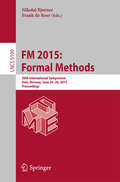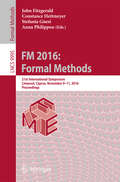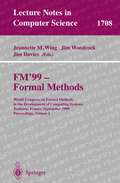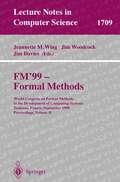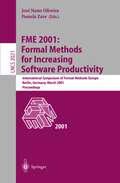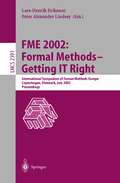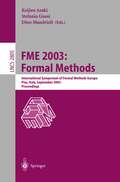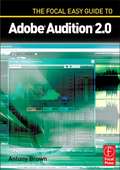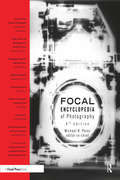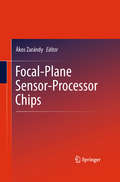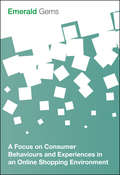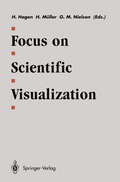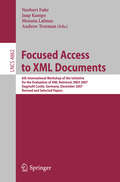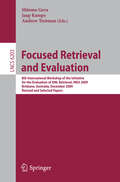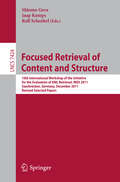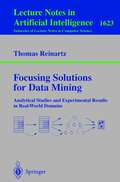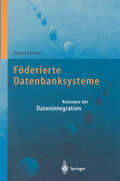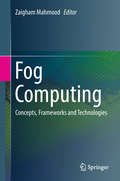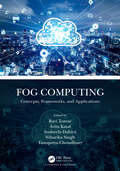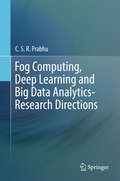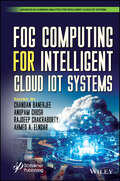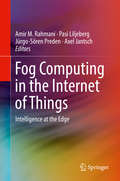- Table View
- List View
FM 2015: 20th International Symposium, Oslo, Norway, June 24-26, 2015, Proceedings (Lecture Notes in Computer Science #9109)
by Nikolaj Bjørner Frank De BoerThis book constitutes the refereed proceedings of the 20th International Symposium on Formal Methods, FM 2015, held in Oslo, Norway, in June 2015. The 30 full papers and 2 short papers presented were carefully reviewed and selected from 124 submissions. The papers cover a wide spectrum of all the different aspects of the use of and the research on formal methods for software development.
FM 2016: 21st International Symposium, Limassol, Cyprus, November 9-11, 2016, Proceedings (Lecture Notes in Computer Science #9995)
by John Fitzgerald Constance Heitmeyer Stefania Gnesi Anna PhilippouThis book constitutes the refereed proceedings of the 21st International Symposium on Formal Methods, FM 2016, held in Limassol, Cyprus, in November 2016. The 38 full papers and 11 short papers presented together with one abstract of an invited talk and one invited presentation were carefully reviewed and selected from 162 submissions. The broad topics of interest for FM include: interdisciplinary formal methods; formal methods in practice; tools for formal methods; role of formal methods in software and systems engineering; theoretical foundations.
FM'99 - Formal Methods: World Congress on Formal Methods in the Developement of Computing Systems, Toulouse, France, September 20-24, 1999, Proceedings, Volume I (Lecture Notes in Computer Science #1708)
by Jeannette M. Wing Jim Woodcook Jim DaviesFormal methods are coming of age. Mathematical techniques and tools are now regarded as an important part of the development process in a wide range of industrial and governmental organisations. A transfer of technology into the mainstream of systems development is slowly, but surely, taking place. FM’99, the First World Congress on Formal Methods in the Development of Computing Systems, is a result, and a measure, of this new-found maturity. It brings an impressive array of industrial and applications-oriented papers that show how formal methods have been used to tackle real problems. These proceedings are a record of the technical symposium ofFM’99:alo- side the papers describingapplicationsofformalmethods,youwill ndtechnical reports,papers,andabstracts detailing new advances in formaltechniques,from mathematical foundations to practical tools. The World Congress is the successor to the four Formal Methods Europe Symposia, which in turn succeeded the four VDM Europe Symposia. This s- cession re?ects an increasing openness within the international community of researchers and practitioners: papers were submitted covering a wide variety of formal methods and application areas. The programmecommittee re?ects the Congress’s international nature, with a membership of 84 leading researchersfrom 38 di erent countries.The comm- tee was divided into 19 tracks, each with its own chair to oversee the reviewing process. Our collective task was a di cult one: there were 259 high-quality s- missions from 35 di erent countries.
FM'99 - Formal Methods: World Congress on Formal Methods in the Development of Computing Systems, Toulouse, France, September 20-24, 1999 Proceedings, Volume II (Lecture Notes in Computer Science #1709)
by Jeannette M. Wing Jim Woodcook Jim DaviesFormal methods are coming of age. Mathematical techniques and tools are now regarded as an important part of the development process in a wide range of industrial and governmental organisations. A transfer of technology into the mainstream of systems development is slowly, but surely, taking place. FM’99, the First World Congress on Formal Methods in the Development of Computing Systems, is a result, and a measure, of this new-found maturity. It brings an impressive array of industrial and applications-oriented papers that show how formal methods have been used to tackle real problems. These proceedings are a record of the technical symposium ofFM’99:alo- side the papers describingapplicationsofformalmethods,youwill ndtechnical reports,papers,andabstracts detailing new advances in formaltechniques,from mathematical foundations to practical tools. The World Congress is the successor to the four Formal Methods Europe Symposia, which in turn succeeded the four VDM Europe Symposia. This s- cession re?ects an increasing openness within the international community of researchers and practitioners: papers were submitted covering a wide variety of formal methods and application areas. The programmecommittee re?ects the Congress’s international nature, with a membership of 84 leading researchersfrom 38 di erent countries.The comm- tee was divided into 19 tracks, each with its own chair to oversee the reviewing process. Our collective task was a di cult one: there were 259 high-quality s- missions from 35 di erent countries.
FME 2001: International Symposium of Formal Methods Europe, Berlin, Germany, March 12-16, 2001, Proceedings (Lecture Notes in Computer Science #2021)
by Jose N. Oliveira Pamela ZaveFME 2001 is the tenth in a series of meetings organized every eighteen months by Formal Methods Europe (FME), an independent association whose aim is to stimulate the use of, and research on, formal methods for software development. It follows four VDM Europe Symposia, four other Formal Methods Europe S- posia, and the 1999 World Congress on Formal Methods in the Development of Computing Systems. These meetings have been notably successful in bringing - gether a community of users, researchers, and developers of precise mathematical methods for software development. FME 2001 took place in Berlin, Germany and was organized by the C- puter Science Department of the Humboldt-Universit¨at zu Berlin. The theme of the symposium was Formal Methods for Increasing Software Productivity. This theme recognizes that formal methods have the potential to do more for industrial software development than enhance software quality { they can also increase productivity at many di erent points in the software life-cycle. The importance of the theme is borne out by the many contributed papers showing how formal methods can make software development more e cient. There is an emphasis on tools that nd errors automatically, or with relatively little human e ort. There is also an emphasis on the use of formal methods to assist with critical, labor-intensive tasks such as program design and test-case generation.
FME 2002: International Symposium of Formal Methods Europe, Copenhagen, Denmark, July 22-24, 2002 Proceedings (Lecture Notes in Computer Science #2391)
by Lars-Henrik Eriksson Peter A. LindsayThis volume contains the proceedings of the 2002 symposium Formal Methods th Europe (FME 2002). The symposium was the 11 in a series that began with a VDM Europe symposium in 1987. The symposia are traditionally held every 18 months. In 2002 the symposium was held at the University of Copenhagen, as part of the 2002 Federated Logic Conference (FLoC 2002), which brought - gether in one event seven major conferences related to logic in computer science, as well as their a?liated workshops, tutorials, and tools exhibitions. Formal Methods Europe (www.fmeurope.org) is an independent association which aims to stimulate the use of, and research on, formal methods for software development. FME symposia have been notably successful in bringing together a community of users, researchers, and developers of precise mathematical - thods for software development. The theme of FME 2002 was “Formal Methods: Getting IT Right”. The double meaning was intentional. On the one hand, the theme acknowledged the signi?cant contribution formal methods can make to Information Technology, by enabling computer systems to be described precisely and reasoned about with rigour. On the other hand, it recognized that current formal methods are not perfect, and further research and practice are required to improve their foundations, applicability, and e?ectiveness.
FME 2003: International Symposium of Formal Methods Europe. Pisa Italy, September 8-14, 2003, Proceedings (Lecture Notes in Computer Science #2805)
by Keijiro Araki Stefania Gnesi Dino MandrioliThisvolumecontainstheproceedingsofFM2003,the12thInternationalFormal Methods Europe Symposium which was held in Pisa, Italy on September 8–14, 2003. Formal Methods Europe (FME, www. fmeurope. org) is an independent - sociation which aims to stimulate the use of and research on formal methods for system development. FME conferences began with a VDM Europe symposium in 1987. Since then, the meetings have grown and have been held about once - ery 18 months. Throughout the years the symposia have been notably successful in bringing together researchers, tool developers, vendors, and users, both from academia and from industry. Unlike previous symposia in the series, FM 2003 was not given a speci?c theme. Rather, its main goal could be synthesized as “widening the scope. ” Indeed, the organizers aimed at enlarging the audience and impact of the symposium along several directions. Dropping the su?x ‘E’ from the title of the conference re?ects the wish to welcome participation and contribution from every country; also,contributionsfromoutsidethetraditionalFormalMethodscommunitywere solicited. The recent innovation of including an Industrial Day as an important part of the symposium shows the strong commitment to involve industrial p- ple more and more within the Formal Methods community. Even the traditional and rather fuzzy borderline between “software engineering formal methods” and methods and formalisms exploited in di?erent ?elds of engineering was so- what challenged.
The Focal Easy Guide To Adobe Audition 2. 0
by Antony BrownSoftware packages are complex. Shouldn't software books make it easier? Simplify your life with the Focal Easy Guide to Adobe (r) Audition (r) 2. 0 This short, full-color book lives up to its name by paring down the software to its essentials. It covers only the key features and essential workflow to get you up and running in no time. When time is of the essence, less is more Antony Brown shares his professional insight to ensure you get the most out of all the tools Adobe's Audition (r) 2. 0 offers. All the essential areas are covered: set up, editing, audio restoration, looping content, working with video, mastering, making a CD, and much more. Featured are many workflow tips that show you how to tap into the full power of Adobe (r) Audition (r) 2. 0 when creating your digital audio files. This is an ideal first read for any editor new to Adobe (r) Audition (r
The Focal Encyclopedia of Photography: From The First Photo On Paper To The Digital Revolution
by Michael R. Peres*Searchable CD ROM containing the entire book (including images) *Over 450 color images, plus never before published images provided by the George Eastman House collection, as well as images from Ansel Adams, Howard Schatz, and Jerry Uelsmann to name just a few The role and value of the picture cannot be matched for accuracy or impact. This comprehensive treatise, featuring the history and historical processes of photography, contemporary applications, and the new and evolving digital technologies, will provide the most accurate technical synopsis of the current, as well as early worlds of photography ever compiled. This Encyclopedia, produced by a team of world renown practicing experts, shares in highly detailed descriptions, the core concepts and facts relative to anything photographic. This Fourth edition of the Focal Encyclopedia serves as the definitive reference for students and practitioners of photography worldwide, expanding on the award winning 3rd edition. In addition to Michael Peres (Editor in Chief), the editors are: Franziska Frey (Digital Photography), J. Tomas Lopez (Contemporary Issues), David Malin (Photography in Science), Mark Osterman (Process Historian), Grant Romer (History and the Evolution of Photography), Nancy M. Stuart (Major Themes and Photographers of the 20th Century), and Scott Williams (Photographic Materials and Process Essentials)
The Focal Encyclopedia of Photography
by Michael R. Peres*Searchable CD ROM containing the entire book (including images) *Over 450 color images, plus never before published images provided by the George Eastman House collection, as well as images from Ansel Adams, Howard Schatz, and Jerry Uelsmann to name just a few The role and value of the picture cannot be matched for accuracy or impact. This comprehensive treatise, featuring the history and historical processes of photography, contemporary applications, and the new and evolving digital technologies, will provide the most accurate technical synopsis of the current, as well as early worlds of photography ever compiled. This Encyclopedia, produced by a team of world renown practicing experts, shares in highly detailed descriptions, the core concepts and facts relative to anything photographic. This Fourth edition of the Focal Encyclopedia serves as the definitive reference for students and practitioners of photography worldwide, expanding on the award winning 3rd edition. In addition to Michael Peres (Editor in Chief), the editors are: Franziska Frey (Digital Photography), J. Tomas Lopez (Contemporary Issues), David Malin (Photography in Science), Mark Osterman (Process Historian), Grant Romer (History and the Evolution of Photography), Nancy M. Stuart (Major Themes and Photographers of the 20th Century), and Scott Williams (Photographic Materials and Process Essentials)
Focal-Plane Sensor-Processor Chips
by Ákos ZarándyFocal-plane sensor-processor imager devices are sensor arrays and processor arrays embedded in each other on the same silicon chip. This close coupling enables ultra-fast processing even on tiny, low power devices, because the slow and energetically expensive transfer of the large amount of sensory data is eliminated. This technology also makes it possible to produce locally adaptive sensor arrays, which can (similarly to the human retina) adapt to the large dynamics of the illumination in a single scene This book focuses on the implementation and application of state-of-the-art vision chips. It provides an overview of focal plane chip technology, smart imagers and cellular wave computers, along with numerous examples of current vision chips, 3D sensor-processor arrays and their applications. Coverage includes not only the technology behind the devices, but also their near- and mid-term research trends.
A Focus on Consumer Behaviours and Experiences in an Online Shopping Environment (Emerald Gems)
by Emerald Group LimitedA Focus on Consumer Behaviours and Experiences in an Online Shopping Environment is a collection of key articles on this topical area of increasing importance. This collection offers insights across a range of sectors. Some of the topics the book looks at include: - Influences of socioeconomic characteristics in online shopping behaviour- Impact of e-service quality, customer perceived value, and customer satisfaction on customer loyalty - The role trust plays in an online shopping environment - The effectiveness of online blogging on consumer purchase decisions In this digital era online shopping is more accessible than it has ever been before and as more people turn to the internet to buy goods and services it's important to understand the consumers' experiences and behaviours. Including articles from prestigious journals such as Internet Research and Journal of Services Marketing this book will be a valuable resource for researches, managers and professionals.
Focus on Scientific Visualization (Computer Graphics: Systems and Applications)
by Hans Hagen Heinrich Müller Gregory M. NielsonOne of the important issues of Scientific Visualization is the utilization of the broad bandwidth of the human sensory system in steering and interpreting complex processes and simulations involving voluminous data sets across diverse scientific disciplines. This book presents the state-of-the-art in visualization techniques both as an overview for the inquiring scientist, and as a solid platform from which developers may extend existing techniques or devise new ones to meet the specific needs of their problems. A secondary goal in crafting this volume has been to provide a vehicle for teaching of state-of-the-art techniques in scientific visualization. The first part of the book covers the application areas fluid flow visualization in medicine, and environmental protection. The second set of chapters explain fundamentals of scientific visualization. It comprises contributions on data structuring and data administration, data modeling, and rendering. A final section is devoted to auditory representation of scientific data.
Focused Access to XML Documents: 6th International Workshop of the Initiative for the Evaluation of XML Retrieval, INEX 2007, Dagstuhl Castle, Germany, December 17-19, 2007, Revised and Selected Papers (Lecture Notes in Computer Science #4862)
by Norbert Fuhr Jaap Kamps Mounia Lalmas Andrew TrotmanThis book constitutes the thoroughly refereed post-conference proceedings of the 6th International Workshop of the Initiative for the Evaluation of XML Retrieval, INEX 2007, held at Dagstuhl Castle, Germany, in December 2007. The 37 revised full papers presented were carefully reviewed and selected for presentation at the workshop from 50 initial submissions. The papers are organized in an ad hoc track and 6 topical sections on book search, XML-mining, entity ranking, interactive, link-the-wiki, and multimedia.
Focused Retrieval and Evaluation: 8th International Workshop of the Initiative for the Evaluation of XML Retrieval, INEX 2009, Brisbane, Australia, December 7-9, 2009, Revised and Selected Papers (Lecture Notes in Computer Science #6203)
by Shlomo Geva Jaap Kamps Andrew TrotmanFocused Retrieval of Content and Structure: 10th International Workshop of the Initiative for the Evaluation of XML Retrieval, INEX 2011, Saarbrücken, Germany, December 12-14, 2011, Revised and Selected Papers (Lecture Notes in Computer Science #7424)
by Shlomo Geva Jaap Kamps Ralf SchenkelThis book constitutes the thoroughly refereed post-workshop proceedings of the 10th International Workshop of the Initiative for the Evaluation of XML Retrieval, INEX 2011, held in Saarbrücken, Germany, in December 2011. The 33 revised full papers presented were carefully reviewed and selected for presentation at the workshop from 36 submissions. The papers are organized in 5 research tracks on book and social search, Xdata centric, question answering, relevance feedback, and snippet retrieval.
Focusing Solutions for Data Mining: Analytical Studies and Experimental Results in Real-World Domains (Lecture Notes in Computer Science #1623)
by Thomas ReinartzIn the first part, this book analyzes the knowledge discovery process in order to understand the relations between knowledge discovery steps and focusing. The part devoted to the development of focusing solutions opens with an analysis of the state of the art, then introduces the relevant techniques, and finally culminates in implementing a unified approach as a generic sampling algorithm, which is then integrated into a commercial data mining system. The last part evaluates specific focusing solutions in various application domains. The book provides various appendicies enhancing easy accessibility.The book presents a comprehensive introduction to focusing in the context of data mining and knowledge discovery. It is written for researchers and advanced students, as well as for professionals applying data mining and knowledge discovery techniques in practice.
Föderierte Datenbanksysteme: Konzepte der Datenintegration
by Stefan ConradDieses Lehrbuch gibt erstmals eine Gesamtdarstellung des Forschungs- und Entwicklungsbereichs Föderierte Datenbanksysteme. Ein zentrales Ziel dieser Systeme ist die Integration bestehender und bislang getrennt verwalteter Datenbestände, insbesondere heterogener Datenbanken. Dabei geht es um einen einheitlichen und transparenten Zugriff, der auch neue, systemübergreifende Anwendungen erlaubt, bei gleichzeitiger Erhaltung der Autonomie der ursprünglichen Systeme. Konzepte, Probleme und Lösungsansätze sowie verschiedene Einsatzbereiche werden exemplarisch vorgestellt. Als wesentliche Grundlagen werden Schemaintegration, semantische Integrität und Transaktionsverwaltung behandelt. Weitere Themen sind Multidatenbanksprachen, Anfragebearbeitung und -optimierung, Sicherheit und aktuelle Systementwicklungen.
Fog Computing: Concepts, Frameworks and Technologies
by Zaigham MahmoodThis authoritative text/reference describes the state of the art of fog computing, presenting insights from an international selection of renowned experts. A particular focus is provided on development approaches, architectural mechanisms, and measurement metrics for building smart adaptable environments. The coverage also includes important related topics such as device connectivity, security and interoperability, and communication methods.Topics and features: introduces the core concepts and principles of fog computing, and reviews the latest research and best practice relating to fog/edge environments; discusses the vision for an Internet of Things (IoT) in terms of fog computing and other related distributed computing paradigms, such as cloud computing; presents a survey of the key issues and broader aspects of the fog paradigm, as well as the factors that affect adoption of fog computing; examines frameworks and methodologies for fog-based architecture design, improving performance, and measuring quality of experience; proposes tools and methodologies for analyzing large amounts of sensor data from smart city initiatives; describes approaches for designing robust services, management of data-intensive applications, context-aware data analysis, and vehicular networking; identifies potential future research directions and technological innovations in relation to distributed computing environments such as the IoT.This enlightening volume offers essential perspectives for researchers of distributed computing and computer networking, as well as for advanced undergraduate and graduate students pursuing interests in this area. Professional engineers seeking to enhance security and connectivity in their IoT systems will also find this work to be a valuable reference.
Fog Computing: Concepts, Frameworks, and Applications
by Ravi Tomar Avita Katal Susheela Dahiya Niharika Singh Tanupriya ChoudhuryFog Computing: Concepts, Frameworks, and Applications is arranged in such a way that readers with no prior experience in Fog Computing may explore this domain. It is an accessible source of information for distributed computing researchers as well as professionals looking to improve their security and connectivity understanding in Internet of Things (IoT) devices. This book is also useful for researchers and professionals working in the field of wireless communication security and privacy research. This book is intended for students, professionals, researchers, and developers who are working in or interested in the field of Fog Computing. One of the book's distinguishing aspects is that it covers a variety of case studies and future possibilities in the field of Fog Computing. This book: Begins by covering the fundamental notions of Fog Computing to help readers grasp the technology, starting from the basics Explains Fog Computing architecture as well as the convergence of Fog, IoT, and Cloud Computing Provides an assessment of Fog Computing and its applications in the field of IoT Discusses the usage of software defined networking and machine learning algorithms as they apply to Fog Computing Describes the different security and privacy issues with Fog Computing and explores single point control systems for consumer devices using Edge-Fog Computing Outlines in detail how to leverage Blockchain technology in Fog Computing, as well as how to use Fog Computing in telemedicine and healthcare applications Examines the usage of communication protocols, simulation tools for Fog Computing implementation, and case studies in the fields of bioinformatics, disaster control, and IoT
Fog Computing: Concepts, Frameworks, and Applications
by Ravi Tomar Avita Katal Susheela Dahiya Niharika Singh Tanupriya ChoudhuryFog Computing: Concepts, Frameworks, and Applications is arranged in such a way that readers with no prior experience in Fog Computing may explore this domain. It is an accessible source of information for distributed computing researchers as well as professionals looking to improve their security and connectivity understanding in Internet of Things (IoT) devices. This book is also useful for researchers and professionals working in the field of wireless communication security and privacy research. This book is intended for students, professionals, researchers, and developers who are working in or interested in the field of Fog Computing. One of the book's distinguishing aspects is that it covers a variety of case studies and future possibilities in the field of Fog Computing. This book: Begins by covering the fundamental notions of Fog Computing to help readers grasp the technology, starting from the basics Explains Fog Computing architecture as well as the convergence of Fog, IoT, and Cloud Computing Provides an assessment of Fog Computing and its applications in the field of IoT Discusses the usage of software defined networking and machine learning algorithms as they apply to Fog Computing Describes the different security and privacy issues with Fog Computing and explores single point control systems for consumer devices using Edge-Fog Computing Outlines in detail how to leverage Blockchain technology in Fog Computing, as well as how to use Fog Computing in telemedicine and healthcare applications Examines the usage of communication protocols, simulation tools for Fog Computing implementation, and case studies in the fields of bioinformatics, disaster control, and IoT
Fog Computing, Deep Learning and Big Data Analytics-Research Directions
by C.S.R. PrabhuThis book provides a comprehensive picture of fog computing technology, including of fog architectures, latency aware application management issues with real time requirements, security and privacy issues and fog analytics, in wide ranging application scenarios such as M2M device communication, smart homes, smart vehicles, augmented reality and transportation management. This book explores the research issues involved in the application of traditional shallow machine learning and deep learning techniques to big data analytics. It surveys global research advances in extending the conventional unsupervised or clustering algorithms, extending supervised and semi-supervised algorithms and association rule mining algorithms to big data Scenarios. Further it discusses the deep learning applications of big data analytics to fields of computer vision and speech processing, and describes applications such as semantic indexing and data tagging. Lastly it identifies 25 unsolved research problems and research directions in fog computing, as well as in the context of applying deep learning techniques to big data analytics, such as dimensionality reduction in high-dimensional data and improved formulation of data abstractions along with possible directions for their solutions.
Fog Computing for Intelligent Cloud IoT Systems (Advances in Learning Analytics for Intelligent Cloud-IoT Systems)
by Chandan Banerjee Anupam Rajdeep Chakraborty Ahmed A. ElngarFOG COMPUTING FOR INTELLIGENT CLOUD IOT SYSTEMS This book is a comprehensive guide on fog computing and how it facilitates computing, storage, and networking services Fog computing is a decentralized computing structure that connects data, devices, and the cloud. It is an extension of cloud computing and is an essential concept in IoT (Internet of Things), as it reduces the burden of processing in cloud computing. It brings intelligence and processing closer to where the data is created and transmitted to other sources. Fog computing has many benefits, such as reduced latency in processing data, better response time that helps the user’s experience, and security and privacy compliance that assures protecting the vital data in the cloud. It also reduces the cost of bandwidth, because the processing is achieved in the cloud, which reduces network bandwidth usage and increases efficiency as user devices share data in the local processing infrastructure rather than the cloud service. Fog computing has various applications across industries, such as agriculture and farming, the healthcare industry, smart cities, education, and entertainment. For example, in the agriculture industry, a very prominent example is the SWAMP project, which stands for Smart Water Management Platform. With fog computing’s help, SWAMP develops a precision-based smart irrigation system concept used in agriculture, minimizing water wastage. This book is divided into three sections. The first section studies fog computing and machine learning, covering fog computing architecture, application perspective, computational offloading in mobile cloud computing, intelligent Cloud-IoT systems, machine learning fundamentals, and data visualization. The second section focuses on applications and analytics, spanning various applications of fog computing, such as in healthcare, Industry 4.0, cancer cell detection systems, smart farming, and precision farming. This section also covers analytics in fog computing using big data and patient monitoring systems, and the emergence of fog computing concerning applications and potentialities in traditional and digital educational systems. Security aspects in fog computing through blockchain and IoT, and fine-grained access through attribute-based encryption for fog computing are also covered. Audience The book will be read by researchers and engineers in computer science, information technology, electronics, and communication specializing in machine learning, deep learning, the cyber world, IoT, and security systems.
Fog Computing for Intelligent Cloud IoT Systems (Advances in Learning Analytics for Intelligent Cloud-IoT Systems)
by Ahmed A. Elngar Rajdeep Chakraborty Anupam Ghosh Chandan BanerjeeFOG COMPUTING FOR INTELLIGENT CLOUD IOT SYSTEMS This book is a comprehensive guide on fog computing and how it facilitates computing, storage, and networking services Fog computing is a decentralized computing structure that connects data, devices, and the cloud. It is an extension of cloud computing and is an essential concept in IoT (Internet of Things), as it reduces the burden of processing in cloud computing. It brings intelligence and processing closer to where the data is created and transmitted to other sources. Fog computing has many benefits, such as reduced latency in processing data, better response time that helps the user’s experience, and security and privacy compliance that assures protecting the vital data in the cloud. It also reduces the cost of bandwidth, because the processing is achieved in the cloud, which reduces network bandwidth usage and increases efficiency as user devices share data in the local processing infrastructure rather than the cloud service. Fog computing has various applications across industries, such as agriculture and farming, the healthcare industry, smart cities, education, and entertainment. For example, in the agriculture industry, a very prominent example is the SWAMP project, which stands for Smart Water Management Platform. With fog computing’s help, SWAMP develops a precision-based smart irrigation system concept used in agriculture, minimizing water wastage. This book is divided into three sections. The first section studies fog computing and machine learning, covering fog computing architecture, application perspective, computational offloading in mobile cloud computing, intelligent Cloud-IoT systems, machine learning fundamentals, and data visualization. The second section focuses on applications and analytics, spanning various applications of fog computing, such as in healthcare, Industry 4.0, cancer cell detection systems, smart farming, and precision farming. This section also covers analytics in fog computing using big data and patient monitoring systems, and the emergence of fog computing concerning applications and potentialities in traditional and digital educational systems. Security aspects in fog computing through blockchain and IoT, and fine-grained access through attribute-based encryption for fog computing are also covered. Audience The book will be read by researchers and engineers in computer science, information technology, electronics, and communication specializing in machine learning, deep learning, the cyber world, IoT, and security systems.
Fog Computing in the Internet of Things: Intelligence at the Edge
by Amir M. Rahmani Pasi Liljeberg Jürgo-Sören Preden Axel JantschThis book describes state-of-the-art approaches to Fog Computing, including the background of innovations achieved in recent years. Coverage includes various aspects of fog computing architectures for Internet of Things, driving reasons, variations and case studies. The authors discuss in detail key topics, such as meeting low latency and real-time requirements of applications, interoperability, federation and heterogeneous computing, energy efficiency and mobility, fog and cloud interplay, geo-distribution and location awareness, and case studies in healthcare and smart space applications.
